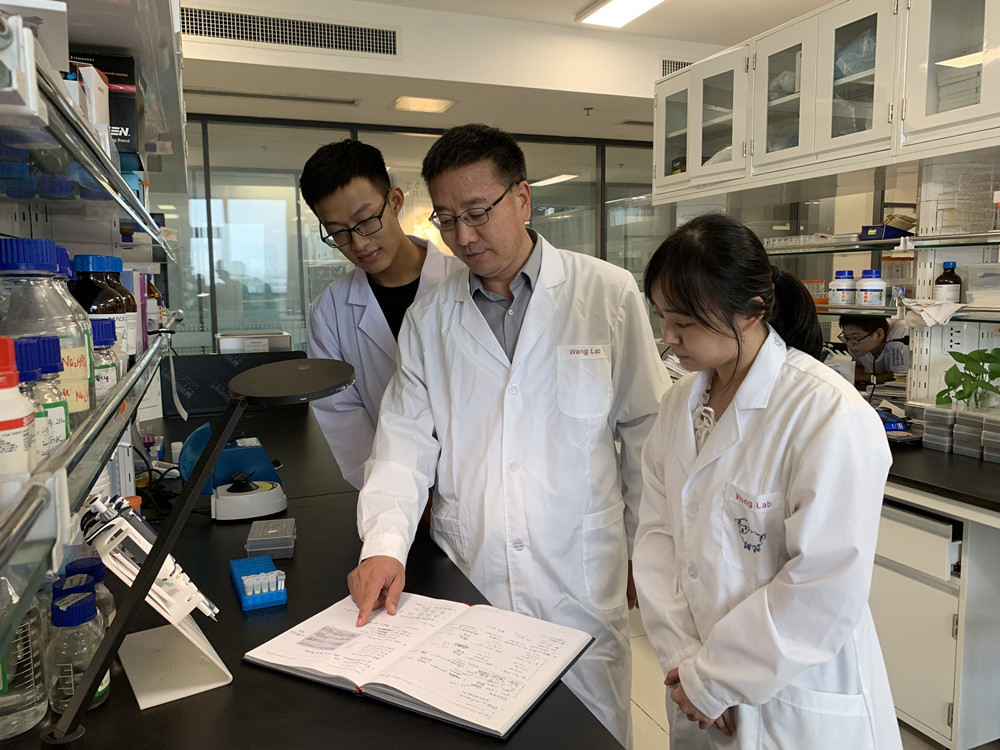
The "Top Ten Scientific and Technological Progress in Chinese Higher Education Institutions" organized by the Science and Technology Committee of the Ministry of Education in 2021 was recently announced. The scientific achievement entitled “Light-induced mobile factors from shoots regulate rhizobium-triggered soybean root nodulation” by Prof. Xuelu Wang’s team was selected as one of the top ten scientific progress.
The Science and Technology Committee of the Ministry of Education has launched the yearly "Top Ten Scientific and Technological progress in China's Higher Education Institutions" since 1998. The aim is to publicize the major scientific and technological achievements, to demonstrate the strength of scientific and technological innovation, and to encourage higher education institutions to improve their scientific and technological innovation capabilities. This achievement of Prof. Wang’s team is the first time ever for Henan University, as well as Henan provincial universities since the award was established. It demonstrates the scientific and technological innovation strength of Henan University, further enhances the reputation and helps the construction of “Double First-Class Discipline” of the university.
Symbiotic nitrogen fixation is the largest natural source of biologically available nitrogen on earth. It affects primary production and carbon sinks in agriculture and natural ecosystems, and plays an important role in the development of green agriculture. Root nodules have been evolved in legume plants to accommodate rhizobia for symbiotic nitrogen fixation, an energy-intensive process. For a long time, light has been considered as the main factor driving symbiotic nitrogen fixation in natural ecosystems. However, how photosynthetic products and light signals regulate nitrogen fixation in legume nodules has been a mystery. The research team of Prof. Xuelu Wang discovered the different roles of photosynthetic products and light signals in regulating the process of symbiotic nodule, and revealed the mechanism by which the CCaMK-STF-FT module integrates the above-ground light signal and the underground symbiotic nitrogen fixation signal to regulate the formation of root nodules. The study was published in Science on October 1, 2021 as a Research Article. It proposed a new mechanism for the coordinated development of plants aboveground and underground parts, and provided a key target for designing novel plants that can symbiotically fix nitrogen even under low light conditions. It provides a new idea for optimizing the carbon-nitrogen balance in agriculture.
Prof. Xuelu Wang's team has long been engaged in the research on plant genetics, plant hormone signal transduction and its interaction with environmental stresses to regulate plant growth and development. The team of "Biological Nitrogen Fixation and Legume Biology", lead by Wang, was established in the State Key Laboratory of Crop Stress Adaptation and Improvement in Henan University. The team uses legume crops to study the genetic, developmental, molecular and evolutionary mechanisms and molecular design-based improvement of leguminous crops. Recently, the team has achieved a series of research advances on soybean symbiotic nitrogen fixation. On December 21, 2020, a research paper was published in Molecular Plant, revealing the molecular mechanism by which soybean GSK3 protein kinase phosphorylates the symbiotic key transcription factor NSP1 and mediates the inhibition of legume-rhizobia symbiosis by salt stress. This study deepens the understanding of the molecular mechanism of salt stress regulating nodule nitrogen fixation, and provides target genes that can be modified and utilized to improve the symbiotic nitrogen fixation ability of soybean and other legumes under environmental stress. On January 15, 2021, research was published in Nature Plants, revealing the genetic, molecular and evolutionary mechanism of the transition of rhizobia from crack-entry infection to root hair infection during the co-evolution of soybean and rhizobia in soybean, which plays an important role in enhancing the symbiotic nitrogen fixation capacity of soybean and improving soybean yield. This study also provides important theoretical basis and target genes for molecular design breeding of high-efficiency nitrogen fixation in soybean. On February 17, 2022, research was published in New Phytologist, revealing the mechanism by which Rhizobium infection triggers the intranuclear replication of soybean symbiotic root nodules. This study not only provides important insights for the in-depth study of many issues in the field of rhizobia and symbiotic nitrogen fixation, but also provides a paradigm for studying the role of endonuclear replication in plant development.
Publications linked to this news:
· Wang, T., Guo, J., Peng, Y., Liu, X., Liu, B., Sun, S., and Wang, X. (2021). Light-induced mobile factors from shoots regulate rhizobium-triggered soybean root nodulation. Science. doi: 10.1126/science.abh2890.https://www.science.org/doi/abs/10.1126/science.abh2890
· Zhang, B., Wang, M., Sun,Y., Zhao, P., Liu,C ., Qing, K., Hu, X., Zhong, Z., Cheng, J.,Wang,H., Peng, Y., Shi, J., Zhuang, L., Du, S., He, M., Wu, H., Liu, M., Chen, S., Wang, H.,Chen, X.,Fan, W., Tian, K.,Wang, Y.,Chen, Q., Wang, S.,Dong, F., Yang, C., Zhang, M., Song, Q., Li, Y., and Wang, X. (2021). Glycine max NNL1 restricts symbiotic compatibility with widely distributed bradyrhizobia via root hair infection. Nature Plants. doi: 10.1038/s41477-020-00832-7. https://www.nature.com/articles/s41477-020-00832-7
· He C., Gao H., Wang H., Guo Y., He M., Peng Y., and Wang X. (2021).GSK3-Mediated Stress Signaling Inhibits Legume–Rhizobium Symbiosis by Phosphorylating GmNSP1 in Soybean. Molecular Plant. doi: 10.1016/j.molp.2020.12.015. https://www.sciencedirect.com/science/article/pii/S1674205220304469
· Fan W, Xia C, Wang S, Liu J, Deng L, Sun S, Wang X. Rhizobial infection of 4C cells triggers their endoreduplication during symbiotic nodule development in soybean. New Phytologist. doi: 10.1111/nph.18036. https://nph.onlinelibrary.wiley.com/doi/abs/10.1111/nph.18036
From: State Key Laboratory of Crop Stress Adaptation and Improvement

 News /
Content
News /
Content


